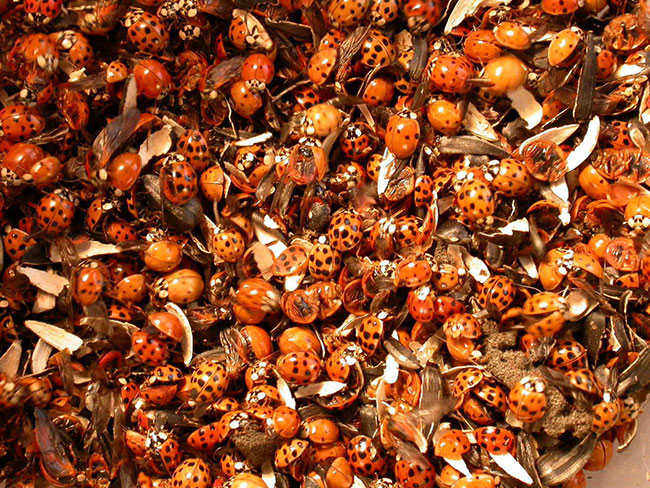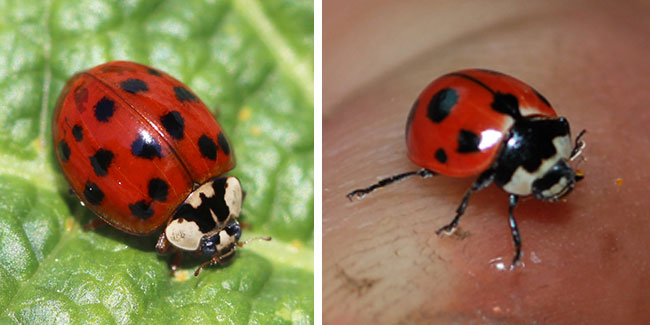Written by Scott Moeller. Scott is an interpretive naturalist and director of the Linnaeus Arboretum at Gustavus Adolphus College. This article originally appeared in the online edition of the St. Peter Herald and has been reposted with the authors permission. The postscript is our own.
If you’ve ventured outside recently, you may have found yourself in a scene reminiscent of the Biblical plagues. That’s because millions of ladybugs have been taking advantage of the warm and sunny days to make their final preparations before winter.
The ladybugs (or lady beetles as they are more correctly called) are leaving their summer stomping-grounds and searching for suitable winter hibernation shelters. Attracted by the heat and light given off by the sunny side of homes and outbuildings, they will congregate and hibernate in large numbers inside your walls and along your foundation.
This pre-hibernation swarm is a natural occurrence among many insects, but there has been a marked increase in the population of certain ladybug species over the past several years. The species that has become the greatest nuisance is the “Multicolored Asian ladybird beetle” (Harmonia axyridis). They vary in coloration from yellow to orange to red, but are most often orange. Each has precisely 19 black spots that vary in darkness from black to nearly invisible.

Where did they come from and why are there so many? Of the 500 or so ladybug species found in North America, nearly 200 are exotic species imported and released as pest control agents. In the mid-1980’s the multicolored Asian ladybird beetle was introduced from Japan by the USDA to aid in fruit tree health (your federal tax dollars at work). But only a few years after their release, none of the introduced beetles could be found, thus ending the experiment.
Several years later, however, the beetle was reintroduced (this time accidentally) from a freighter in the port of New Orleans. This time the beetles survived. By the early 90’s they had spread to the southeastern U.S., and by 1994, they reached the midwest, thus explaining why our garage walls are now orange. It’s still a bit too soon to know just what impact these new ladybugs will have on native insect populations.
But for all the commotion we make about these visitors, they are incapable of doing any real damage to the structure of your home. They will, however, emit an unpleasant odor if they are particularly stressed or agitated (but, then again, so will I). The odor actually comes from blood discharged from the leg joints. This “reflex bleeding” is a common trait of all ladybug species. So, just make sure your ladybugs are relaxed, and there won’t be any trouble.
Despite being an invasive species and an indoor nuisance, there may be a bright side. Ladybugs are widely regarded as some of the most beneficial of all insects. Known as the T-rex of the insect world, they eat prolific quantities of harmful aphids and other pests.
So treat your new house guests kindly, and make the most of the situation … Paint little numbers on their backs, then race them and wager on the outcome.
If you’re not into insect-related gambling, there are a few things you can do to remove or reduce the numbers of them in your home. You can physically remove them with a vacuum cleaner by inserting a nylon stocking inside the extension hose and securing it with a rubber band to collect the beetles and release them back outside.
There are chemical sprays that will help keep them away, but keep in mind that these sprays can also be harmful to your family and pets, as well as beneficial native insects.
Some timely caulking and weatherizing can help to reduce the number that enter your house next year. The beetles are attracted by heat in the fall, so you can also minimize the chance of the them finding your home by planting trees and shrubs to shade the sides of the dwelling (or divert them away from your property by painting your neighbor’s house jet black).
Postscript: The Lost Ladybug
In 1989, around the time that the multicolored Asian lady beetle was introduced by the USDDA, New York designated the nine-spotted lady beetle as the state insect. It was then believed to be one of the most common and important lady beetles in agricultural areas in New York and the Northeast. Today it seems to be extirpated (made locally extinct) within the state, and it occupies only a tiny fraction of its former range across the United States and southern Canada.

Recent surveys have found none in the Northeast, and only a few in the Midwest and West – although many are still looking. In 2000, the Lost Ladybug Project began as a joint effort between researchers at Cornell and New York Extension Master Gardeners to survey lady beetles across New York state. The project has since expanded into a citizen science project offering many useful guides and information, as well as a place to record lady beetle observations.
Although the nine-spot’s decline was recent, little is known about why it vanished. Non-native lady beetles may have brought disease, eaten prey used by the nine-spot, or even eaten the nine-spot itself. The exact cause of the demise of the nine-spotted lady beetle continues to be investigated.
For more information view our profile on the nine-spotted lady beetle, and visit lostladybug.org.



